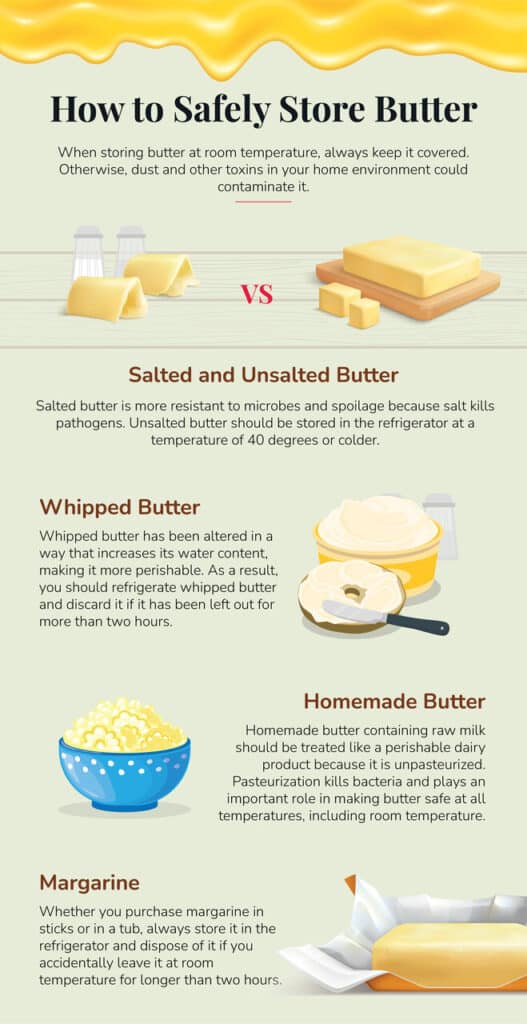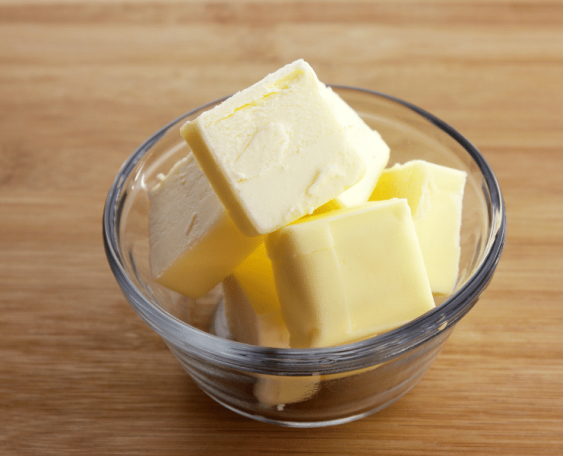How to Safely Store Butter?
When storing butter at room temperature, always keep it covered. Otherwise, dust and other toxins in your home environment could contaminate it. If other foods splatter onto it during cooking, you get toast crumbs on it, or it comes into contact with raw meat, it could become contaminated with harmful bacteria.
When storing butter in the refrigerator, you should keep it covered to prevent it from absorbing odors, contacting raw meat, and becoming contaminated with pathogens that could be present in the refrigerator without your knowledge. Even unwashed produce can harbor dangerous bacteria and silently create an unsafe environment in your refrigerator.
Butter is approximately 80 percent fat and 20 percent water. The fat surrounds the water, making it difficult for bacteria to infiltrate it. However, over time, the water interacts with the fat, ultimately leading to rancid butter. This process occurs faster if the butter is stored uncovered.

Is There a Difference in How Salted and Unsalted Butter Should Be Stored?
Salted butter is more resistant to microbes and spoilage because salt kills pathogens. Unsalted butter should be stored in the refrigerator at a temperature of 40 degrees or colder. The maximum time you can safely store unsalted butter at temperatures above 40 degrees is two hours.
Whipped Butter
Whipped butter has been altered in a way that increases its water content, making it more perishable. As a result, you should refrigerate whipped butter and discard it if it has been left out for more than two hours.
Homemade Butter
Homemade butter containing raw milk should be treated like a perishable dairy product, like milk, because it is unpasteurized. Unpasteurized raw milk can harbor harmful bacteria that could contaminate the finished product. Pasteurization kills bacteria and plays an important role in making butter safe at all temperatures, including room temperature.
Even if you make your homemade butter from pasteurized cream, it is still more perishable if you make it outside of a sterile environment. It also may not contain the correct amount of salt to protect it from pathogenic growth.
Margarine
Despite its similar taste and appearance, margarine is not butter, and it contains less fat. Whether you purchase margarine in sticks or in a tub, always store it in the refrigerator and dispose of it if you accidentally leave it at room temperature for longer than two hours.
What Happens to Butter When It Sits Out for Too Long?
When butter sits out for too long, the water that is encased in fat eventually breaks down the fat and makes the butter vulnerable to contamination by:
- Staphylococcus aureus (Staph)
- Listeria monocytogenes
- Yersinia enterocolitica
All of these bacteria can contaminate unsalted butter, margarine, whipped butter, and homemade butter. Stick butter with a salt content of at least three percent is generally more resistant to listeria and yersinia, but not staph.
What Happens if You Ingest Butter That Has Gone Bad?
If you get a staph infection from consuming bad butter, you may experience gastrointestinal distress, dehydration, and low blood pressure. Staph infections from food poisoning typically resolve in less than a day. You may experience similar gastrointestinal symptoms if you contract listeriosis or yersiniosis.
Listeria can spread to the nervous system and cause severe symptoms, including seizures, confusion, and secondary infections. Pregnant women have a higher risk of contracting listeriosis and passing it to the fetus. This may lead to a miscarriage.
Complications from yersiniosis could include skin rashes, joint pains, and septicemia. Children are more likely than adults to contract yersiniosis. Joint pain from yersiniosis can become reactive arthritis and last as long as six months.
Signs that Butter Has Gone Bad
Dangerous bacteria can form in butter without any changes in how the butter looks, smells, or tastes. This is why it is crucial that you avoid consuming butter that was stored outside the refrigerator for longer than two days. Butter that has spoiled due to slow-growing microorganisms may develop mold, an unusually shiny gloss, or a strange smell. If you notice any of these changes, throw it away. Do not eat it.
Can You Put Butter Back in the Fridge After Leaving it Out?
If your butter has already been left out for too long or if you have already noticed signs that it has become rancid, putting it in the refrigerator will not fix it. You can safely put butter back in the refrigerator after it has been left out for less than two days, but you may notice a shorter shelf life.
How Long Until Butter Goes Bad in the Refrigerator?
You can generally store butter in the refrigerator for one to two months before the fat in your butter begins to oxidize and become rancid. If you are unable to use up your butter within this time, you can store it in the freezer for six to nine months.
Butter Food Poisoning Outbreaks
In August of 2022, Epicurean Butter announced a recall of its 3.5-ounce tubs of Wegmans Lemon Dill Finishing Butter due to potential Listeria contamination in the frozen dill product used to flavor the butter. The recalled tubs were sold in Wegmans Food Markets in eight states along the East Coast.





